|
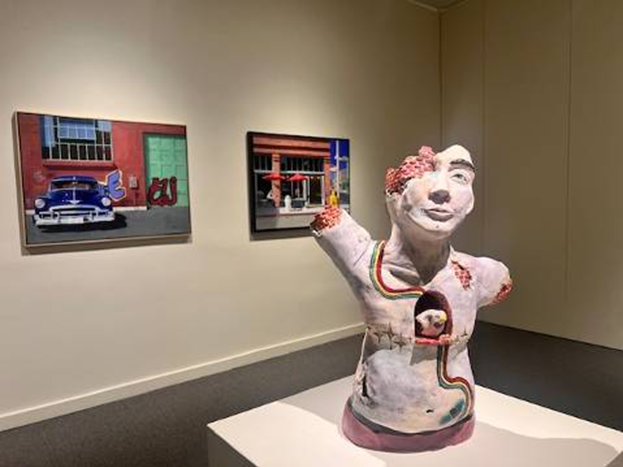

Opening Friday, Oct 24, with a reception from 7 to 9 pm, the Art Guild of Pacifica will be celebrating local artists with their 67th Annual Members Show! Over 90 entries — nearly half of over 200 members in the Guild — submitted work for the Show. Their artworks are a stirring mix including paintings in oil, acrylic and watercolor; pen and ink, fiber and textile works; linocut and screen print, various photographic processes and 3D sculptures, reflecting an exciting range of style and mediums. Eileen David, Adjunct Professor Studio Arts, Skyline College, will be selecting this year's awards. Live music at the opening will be provided by local musician (and AGP visual artist) Michael Foley.

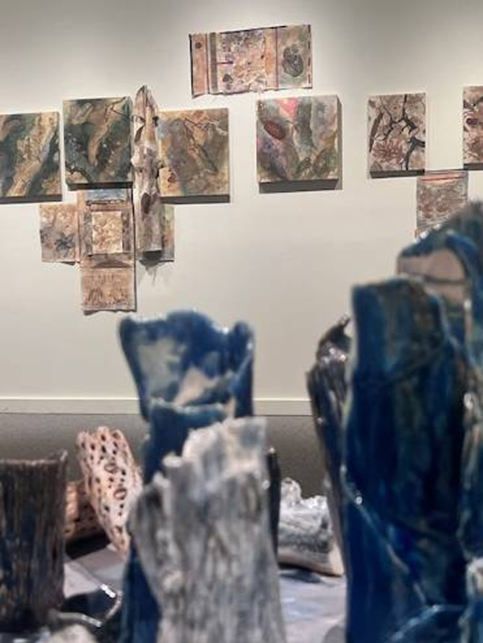

Featured concurrently in the Main Gallery are the 66th Annual Awards Exhibition artists, Ash Asaro (ceramics), Tim Berry (mixed media paintings + eco prints), Charles McDevitt (acrylic paintings), and Julie Stock (ceramic + acrylic and charcoal on canvas). Jenna Erwin, Project Manager, Exhibitions & Publication, Oakland Museum of California (OMCA), who judged last year's show, visited each Exhibition Award artist to select works to present this year. The artists will be in conversation with Erwin on Sunday, Nov 2 at 3:30 pm in the Main Gallery.
Both the 67th Annual Members Show and the 66th Annual Awards Exhibition will be on view through Sunday, Nov 23.

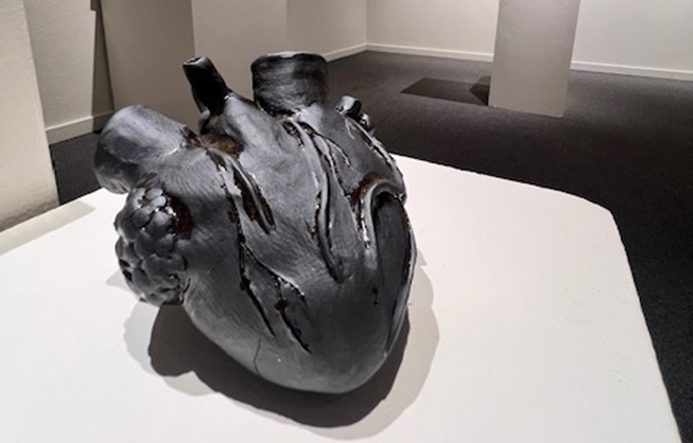

A talented artist in several mediums, Ash Asaro is especially known for their work in ceramic sculpture, noting that he "loves the tactility of the medium, along with the challenges it provides along the way". It was their surrealistic ceramic jar "Wishing Eye Was There" that captivated last year's judge and garnered them an exhibition award. While that work featured a winged cyclops eye and birds — a frequent theme in Asaro's work — some of the pieces in this year's show include another recurring focus of the artist, ceramic "anatomical" hearts that both respect the natural form while adding a fantastical characteristic twist. Two works utilize obsidian clay including the powerful little piece "Bite the Hand that Loves You" with a dog mouth at the base of the heart.
Asaro endeavors for his work to be an emotional reflection on the personal internal world tied to the horrors of watching the external world, particularly the environment, get worse. He has always considered art the best way to process and visualize more complex and tangled feelings about the intersectional experience of being alive.
Ash Asaro attended Terra Nova High School in Pacifica and has an Associate of Arts degree from Skyline College in Fine/Studio Arts. Their Bachelor of Arts from San Francisco State University was earned while supporting the Art Department at Skyline College as studio art lab coordinator, a position they continue to hold.
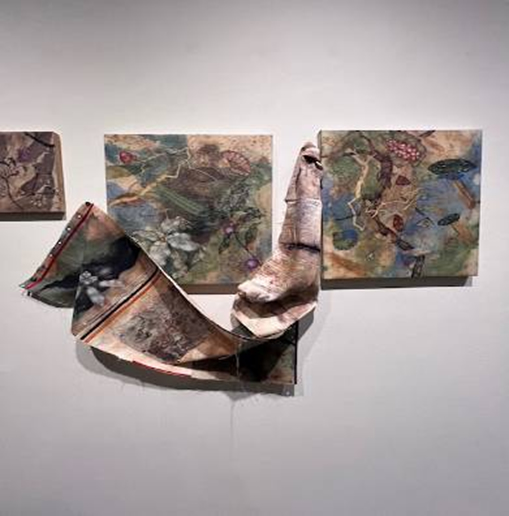

"Closer to Free", an installation of the work of Timothy Berry, presents a body of mixed media paintings and eco prints incorporating asphaltum and alkyd paint on Okawara paper and silk textile. In both content and creation, the Berry's art is a tribute to Nature and all of its inhabitants. Berry reflects that, "Nature at its best is chaotic, ad mankind's relationship with nature is both contentious and appreciative. Our exclusion, either ordained or by choice, represents a Paradise Lost".
Content appears evident through represented images. Creation is randomly applied materials (i.e., staining, mono printing) over previously mentioned "images", each layer "reacting" to every other layer that went before. A sense of time and history is always present. Berry believes, "There is much more evidence in the way things are done than in the way things look, although the final evidence must be in the way things make one feel".
Berry has been a practicing artist for over 30 years. His paintings, drawings, and prints have been exhibited extensively in museums and galleries in both the United States and Europe. He is also an arts educator, including more than three decades at the San Francisco Art Institute. The body of work in the exhibition was created in his current studio at Sanchez Art Center.
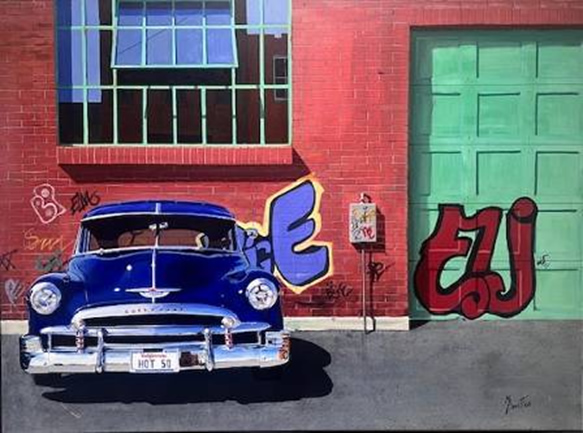

Charles Dennis McDevitt is essentially a realist painter, whose work approaches photorealism. McDevitt attempts to portray, through the use of form and color, the changes in temperature between light and shadow as well as what the viewer sees. He notes, "Due to the nature of the painting style, I encounter each painting as a number of abstract components within the confines of the work, realizing the full visual impact as the painting progresses".
Having a keen interest in manmade objects, and how they cohabitate with their natural surroundings at different times of the day, McDevitt's paintings feel like one could step into them, or reach out and touch the items portrayed. In "Recent Works", acrylic on canvas, a vivid deep blue 1950 Chevrolet gleams in the sun in front of a building marked with graffiti, while the streetscape across the way is reflected in the shiny chrome of the bumper and windows of the detailed brick building. "Green Apple Refuge" delightfully portrays the beloved community space Green Apple Books on Clement Street, from the mural over the green awning to the rolling shelves of books and familiar characters.
Born and raised in San Francisco, McDevitt received his Bachelor of Arts from the California College of Arts and Crafts, graduating in 1966, with a degree in Industrial Arts and minor in Fine Art. He also works out of his studio at Sanchez Art Center.


Echoing the theme of nature, the work being shown by Julie Stock includes modular groupings of seeds, shells, trunks and leaves that breathe the energy of life; they gather in elegy to the abundance of being. In three mixed media installations, ceramics, acrylic and charcoal on canvas are featured; the canvases provide a literal backdrop for the free-formed ceramics, presented as pedestal mounted tableau. The canvas for "Origin" with its light hues of yellow and gray, created with bold free form marks and egg shaped forms scattered on the foreground, are paired with "open" broken modules appearing to be eggs of beings that have entered the world. Opposite, deep blues form a dreamy backdrop in "Breathe" that causes viewers to pause to reflect on if it's a night scene or a glimpse into the forest primeval from a brooding fairy tale brought to life.
Stock nurtures her art practice, dedicating weekly time to the creative process. Images come into her imagination, and she then determines which of her many mediums to realize them in. Embracing mistakes, she notes that "Surprises often lead to more interesting results than planned artwork. I like to discover a inspired feeling, awareness in the material or a scene or a moment." She explores the primal nature of things, truth and justice, and natural forces.
Originally from Long Island, NY, Stock was educated at SUNY Stony Brook NY, focusing on Art Studio practices, Art History and Criticism. She also has her Secondary Education Teaching Credential, and inspires students at a public high school, teaching drawing and design.
In addition to the two exhibitions, Art Guild of Pacifica members will also be sharing a variety of art cards and gifts in the Shop.
Sanchez Art Center is located at 1220 Linda Mar Blvd, Pacifica, about a mile east of Highway 1. Following opening night, galleries are open Friday, Saturday, and Sunday, 1–5 pm, and by appointment, through Nov 23. For more information: www.SanchezArtCenter.org or info@SanchezArtCenter.org. Visit the Art Guild of Pacifica website (www.ArtGuildofPacifica.org) to learn more about AGP including how to become a member and the benefits. |